Contextual Modulation of Adult–Child Language Interaction: Semantic Network Connectivity and Children’s Vocabulary Development
Abstract
:1. Introduction
2. Materials and Methods
2.1. Dataset
2.2. Measures
2.3. Analytic Strategy
3. Results
3.1. RQ 1. Does Adults’ Use of Semantically Relevant Conversation Vary across Activity Settings (Book Reading, Toy Play, and Mealtime)?
3.1.1. Short Path Length and Diameter
3.1.2. Density
3.1.3. Clustering Coefficient
3.2. RQ 2. Do Children Show a Higher Degree of Expressive Language Skill, When Adults Engage in More Semantically Relevant Conversation within Each Activity Context?
4. Discussion
5. Conclusions
Author Contributions
Funding
Institutional Review Board Statement
Informed Consent Statement
Data Availability Statement
Conflicts of Interest
References
- Mayor, J.; Plunkett, K.A. Statistical Estimate of Infant and Toddler Vocabulary Size from CDI Analysis. Dev. Sci. 2011, 14, 769–785. [Google Scholar] [CrossRef] [PubMed]
- Yurovsky, D.; Smith, L.; Yu, C. Statistical Word Learning at Scale: The Baby’s View is Better. Dev. Sci. 2013, 16, 959–966. [Google Scholar] [CrossRef]
- Markman, E. Constraints Children Place on Word Meanings. Cogn. Sci. 1990, 14, 57–77. [Google Scholar] [CrossRef]
- Yuan, S.; Fisher, F.; Snedeker, J. Counting the Nouns: Simple Structural Cues to Verb Meaning. Child Dev. 2012, 83, 1382–1399. [Google Scholar] [CrossRef] [PubMed]
- Braginsky, M.; Yurovsky, D.; Marchman, V.; Frank, M. Consistency and Variability in Children’s Word Learning Across Languages. Open Mind 2019, 3, 52–67. [Google Scholar] [CrossRef]
- Goodman, J.; Dale, P.; Li, P. Does Frequency Count? Parental Input and the Acquisition of Vocabulary. J. Child Lang. 2008, 35, 515–531. [Google Scholar] [CrossRef]
- Hadley, E.; Dickinson, D.; Hirsh-Pasek, K.; Golinkoff, R. Building Semantic Networks: The Impact of a Vocabulary Intervention on Preschoolers’ Depth of Word Knowledge. Read. Res. Q. 2019, 54, 41–61. [Google Scholar] [CrossRef]
- Fourtassi, A.; Bian, Y.; Frank, M. The Growth of Children’s Semantic and Phonological Networks: Insight from 10 Languages. Cogn. Sci. 2020, 44, e12847. [Google Scholar] [CrossRef]
- Borovsky, A.; Ellis, E.; Evans, J.; Elman, J. Lexical Leverage: Category Knowledge Boosts Real-time Novel Word Recognition in 2-year-olds. Dev. Sci. 2016, 19, 918–932. [Google Scholar] [CrossRef]
- Tannenbaum, K.; Torgesen, J.; Wagner, R. Relationships Between Word Knowledge and Reading Comprehension in Third-grade Children. Sci. Stud. Read. 2006, 10, 381–398. [Google Scholar] [CrossRef]
- Anderson, R.; Freebody, P. Vocabulary knowledge. In Theoretical Models and Processes of Reading, 3rd ed.; Singer, H., Ruddell, R., Eds.; International Reading: Newark, NJ, USA, 1985; pp. 343–371. [Google Scholar]
- Perfetti, C. Reading Ability: Lexical Quality to Comprehension. Sci. Stud. Read. 2007, 11, 357–383. [Google Scholar] [CrossRef]
- Steyvers, M.; Tenenbaum, J. The Large-scale Structure of Semantic Networks: Statistical Analyses and a Model of Semantic Growth. Cogn. Sci. 2005, 29, 41–78. [Google Scholar] [CrossRef]
- Stanovich, K. Matthew Effects in Reading: Some Consequences of Individual Differences in the Acquisition of Literacy. J. Educ. 2009, 189, 23–55. [Google Scholar] [CrossRef]
- Hills, T.; Maouene, M.; Maouene, J.; Sheya, A.; Smith, L. Longitudinal Analysis of Early Semantic Networks: Preferential Attachment or Preferential Acquisition? Psychol. Sci. 2009, 20, 729–739. [Google Scholar] [CrossRef]
- Smith, L.; Yu, C. Infants Rapidly Learn Word-referent Mappings via Cross-situational Statistics. Cognition 2008, 106, 1558–1568. [Google Scholar] [CrossRef]
- Yurovsky, D.; Frank, M. An Integrative Account of Constraints on Cross-situational Learning. Cognition 2015, 145, 53–62. [Google Scholar] [CrossRef] [PubMed]
- Bolger, D.; Balass, M.; Landen, E.; Perfetti, C. Context Variation and Definitions in Learning the Meanings of Words: An Instance-based Learning Approach. Discourse Process. 2008, 45, 122–159. [Google Scholar] [CrossRef]
- Nagy, W.; Townsend, D. Words as Tools: Learning Academic Vocabulary as Language Acquisition. Read. Res. Q. 2012, 47, 91–108. [Google Scholar] [CrossRef]
- Dickinson, D.; Hofer, K.; Barnes, E.; Grifenhagen, J. Examining Teachers’ Language in Head Start Classrooms from a Systemic Linguistics Approach. Early Child. Res. Q. 2014, 29, 231–244. [Google Scholar] [CrossRef]
- Halliday, M. Towards a Language-based Theory of Learning. Ling. Educ. 1993, 5, 93–116. [Google Scholar] [CrossRef]
- Schleppegrell, M. Academic Language in Teaching and Learning: Introduction to the Special Issue. Elem. Sch. J. 2012, 112, 409–418. [Google Scholar] [CrossRef]
- Salo, V.C.; Rowe, M.L.; Leech, K.A.; Cabrera, N.J. Low-Income Fathers’ Speech to Toddlers During Book Reading Versus Toy Play. J. Child Lang. 2016, 43, 1385–1399. [Google Scholar] [CrossRef] [PubMed]
- Thompson, G. Introducing Functional Grammar; Taylor & Francis: New York, NY, USA, 2013. [Google Scholar]
- Demir-Lira, E.; Applebaum, L.; Goldin-Meadow, S.; Levine, S. Parents’ Early Book Reading to Children: Relation to Children’s Later Language and Literacy Outcomes Controlling for Other Parent Language Input. Dev. Sci. 2019, 22, e12764. [Google Scholar] [CrossRef]
- White, A.; Hacquard, V.; Resnik, P.; Lids, J. The Contextual Modulation of Semantic Information. Available online: http://aaronstevenwhite.io/papers/white_contextual_2016.pdf (accessed on 15 October 2023).
- Jang, W. Early Childhood Teachers’ Characteristics, Complex Talk, and Children’s Language and Literacy Development. Ph.D. Thesis, The University of North Carolina at Chapel Hill, Chapel Hill, NC, USA, 2022. [Google Scholar]
- Barnes, E.; Grifenhagen, J.; Dickinson, D. Academic Language in Early Childhood Classrooms. Read. Teach. 2016, 70, 39–48. [Google Scholar] [CrossRef]
- Dickinson, D.K.; Tabors, P.O. Beginning Literacy with Language: Young Children Learning at Home and School; Paul Brookes Publishing: Baltimore, MD, USA, 2001. [Google Scholar]
- Carl, E. The Very Hungry Caterpillar; Collins Publishers: New York, NY, USA, 1979. [Google Scholar]
- Snow, C.; Dickinson, D. Social Sources of Narrative Skills at Home and at School. First Lang. 1990, 10, 87–103. [Google Scholar] [CrossRef]
- Beals, D.; Tabors, P. Arboretum, Bureaucratic, and Carbohydrates: Preschoolers’ Exposure to Rare Vocabulary at Home. First Lang. 1995, 15, 57–76. [Google Scholar]
- Stubbs, M. Text and Corpus Analysis; Blackwell Publisher: Oxford, UK, 1996. [Google Scholar]
- Gablasova, D.; Brezina, V.; McEnery, T. Collocations in Corpus-Based Language Learning Research: Identifying, Comparing, and Interpreting the Evidence. Lang. Learn. 2017, 67, 155–179. [Google Scholar] [CrossRef]
- Wasserman, S.; Faust, K. Social Network Analysis: Methods and Applications; Cambridge University Press: Cambridge, UK, 1994. [Google Scholar]
- Pereira, J.; Mijalkov, M.; Kakaei, E.; Mecocci, P.; Vellas, B.; Tsolaki, M.; Kłoszewska, I. Disrupted Network Topology in Patients with Stable and Progressive Mild Cognitive Impairment and Alzheimer’s Disease. Cereb. Cortex 2016, 26, 3476–3493. [Google Scholar] [CrossRef]
- Watts, D.; Strogatz, S. Collective Dynamics of Small-world Networks. Nature 1998, 393, 440–442. [Google Scholar] [CrossRef]
- Kenett, Y.; Anaki, D.; Faust, M. Investigating the Structure of Semantic Networks in Low and High Creative Persons. Front. Hum. Neurosci. 2014, 8, 407. [Google Scholar] [CrossRef]
- Siew, C.; Wulff, D.; Beckage, N.; Kenett, Y. Cognitive Network Science: A Review of Research on Cognition Through the Lens of Network Representations, Processes, and Dynamics. Complexity 2019, 2108423. [Google Scholar] [CrossRef]
- Borge-Holthoefer, J.; Arenas, A. Semantic Networks: Structure and Dynamics. Entropy 2010, 12, 1264–1302. [Google Scholar] [CrossRef]
- Fitzgerald, J.; Elmore, J.; Relyea, J.; Stenner, A. Domain-Specific Academic Vocabulary Network Development in Elementary Grades Core Disciplinary Textbooks. J. Educ. Psychol. 2020, 112, 855–879. [Google Scholar] [CrossRef]
- Wasik, B.; Hindman, A.; Snell, E. Book Reading and Vocabulary Development: A Systematic Review. Early Child. Res. Q. 2016, 37, 39–57. [Google Scholar] [CrossRef]
- Cabell, S.; DeCoster, J.; LoCasale-Crouch, J.; Hamre, B.; Pianta, R. Variation in the Effectiveness of Instructional Interactions Across Preschool Classroom Settings and Learning Activities. Early Child. Res. Q. 2013, 28, 820–830. [Google Scholar] [CrossRef]
- Hoff, E. Context Effects on Young Children’s Language Use: The Influence of Conversational Setting and Partner. First Lang. 2010, 30, 461–472. [Google Scholar] [CrossRef]
- Burchinal, M.; Garber, K.; Foster, T.; Bratsch-Hines, M.; Franco, X.; Peisner-Feinberg, E. Relating Early Care and Education Quality to Preschool Outcomes: The Same or Different Models for Different Outcomes? Early Child. Res. Q. 2021, 55, 35–51. [Google Scholar] [CrossRef]
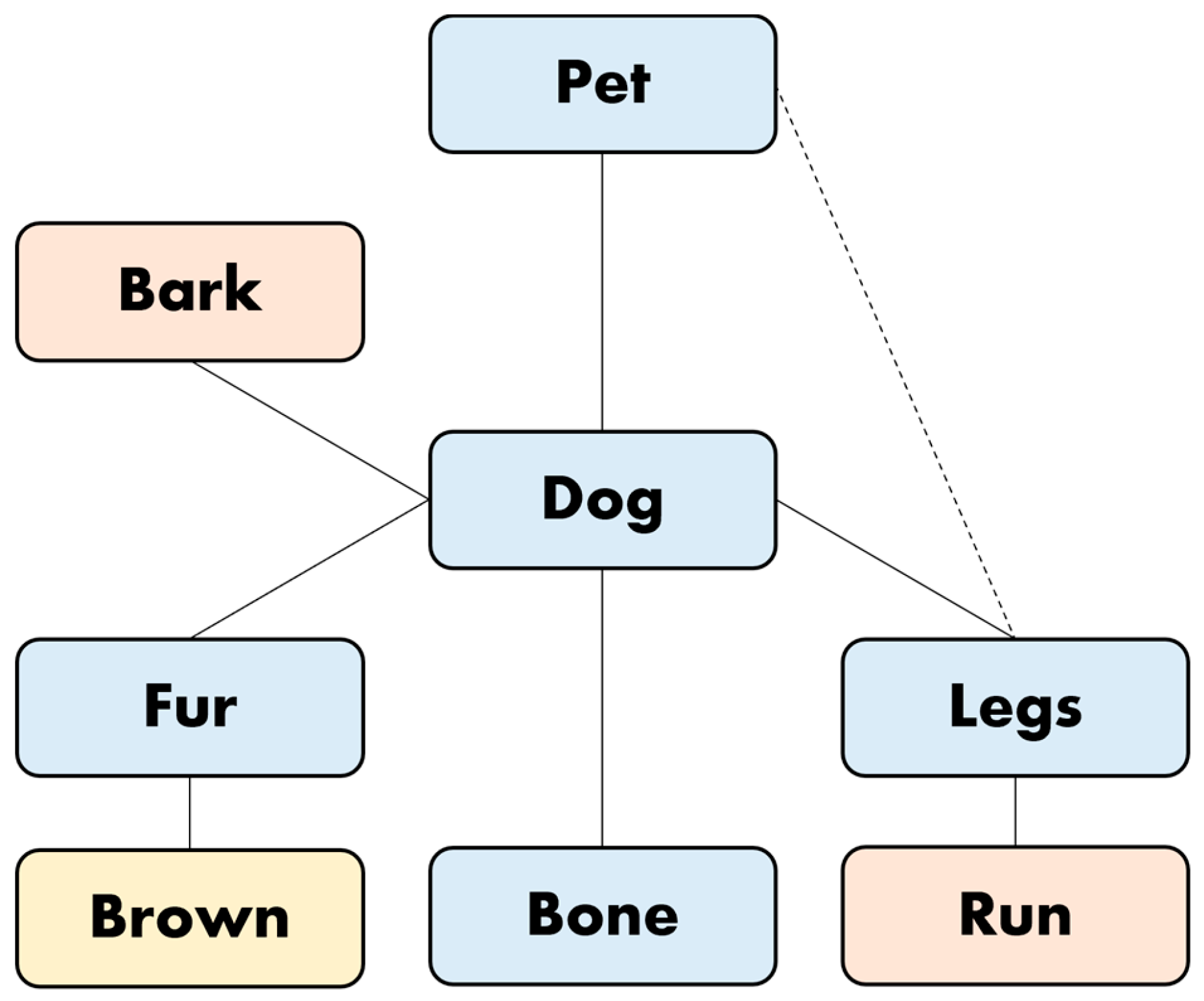
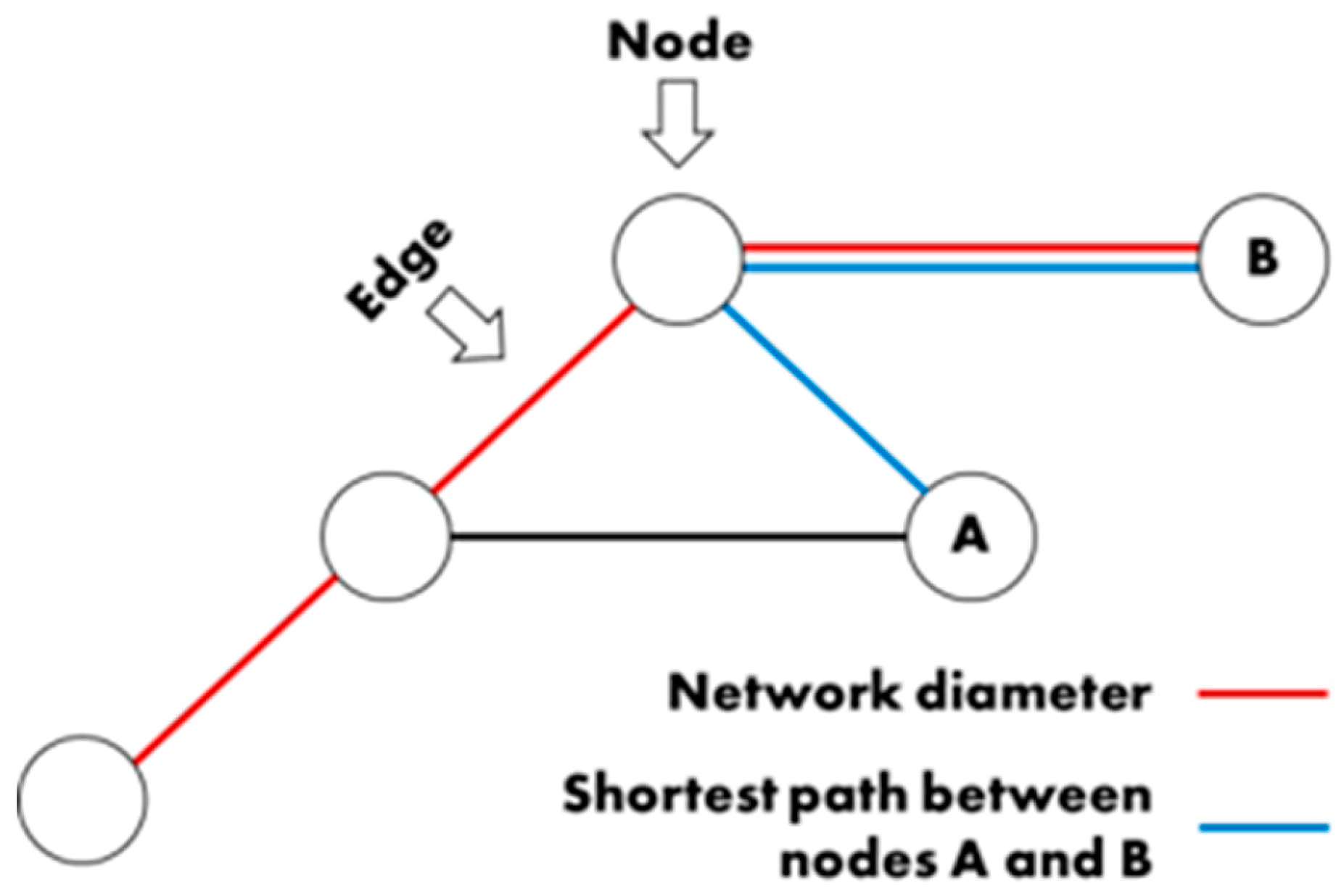

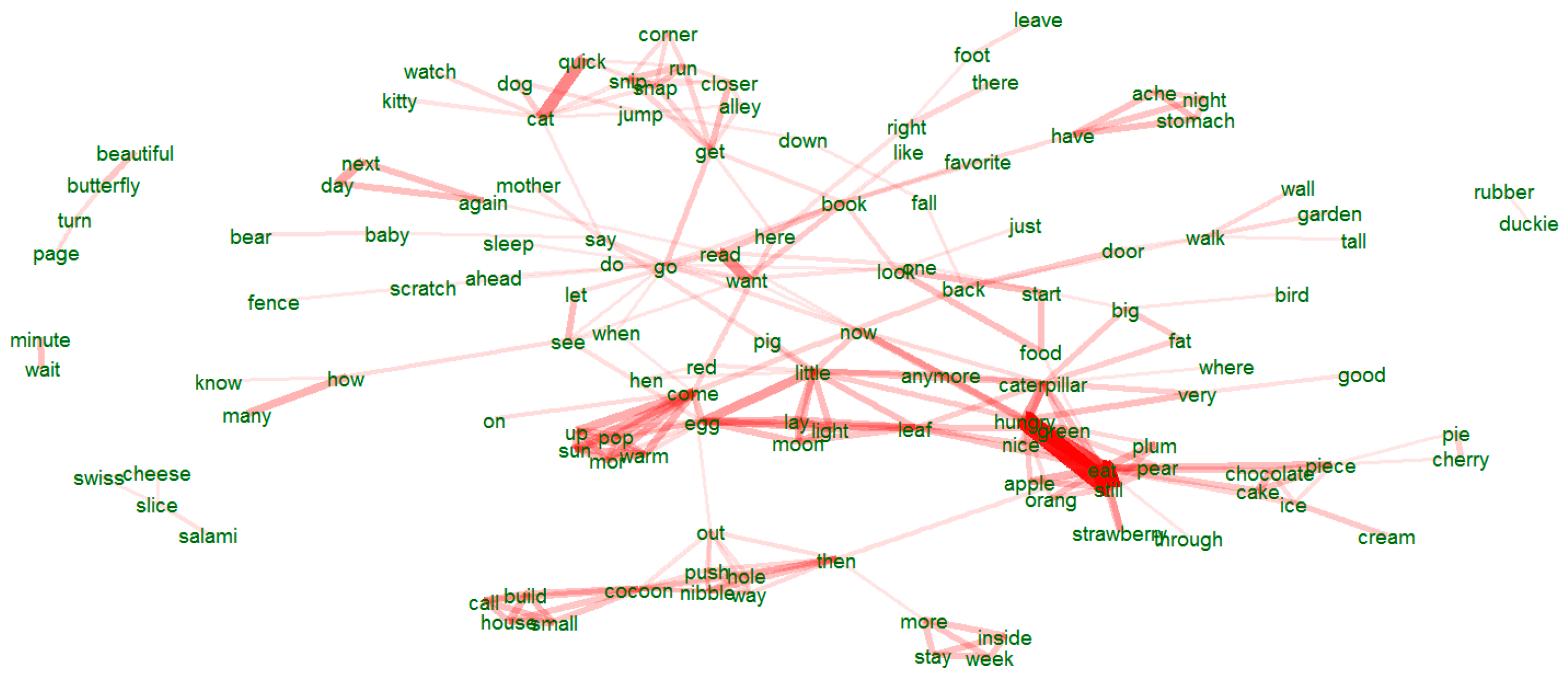
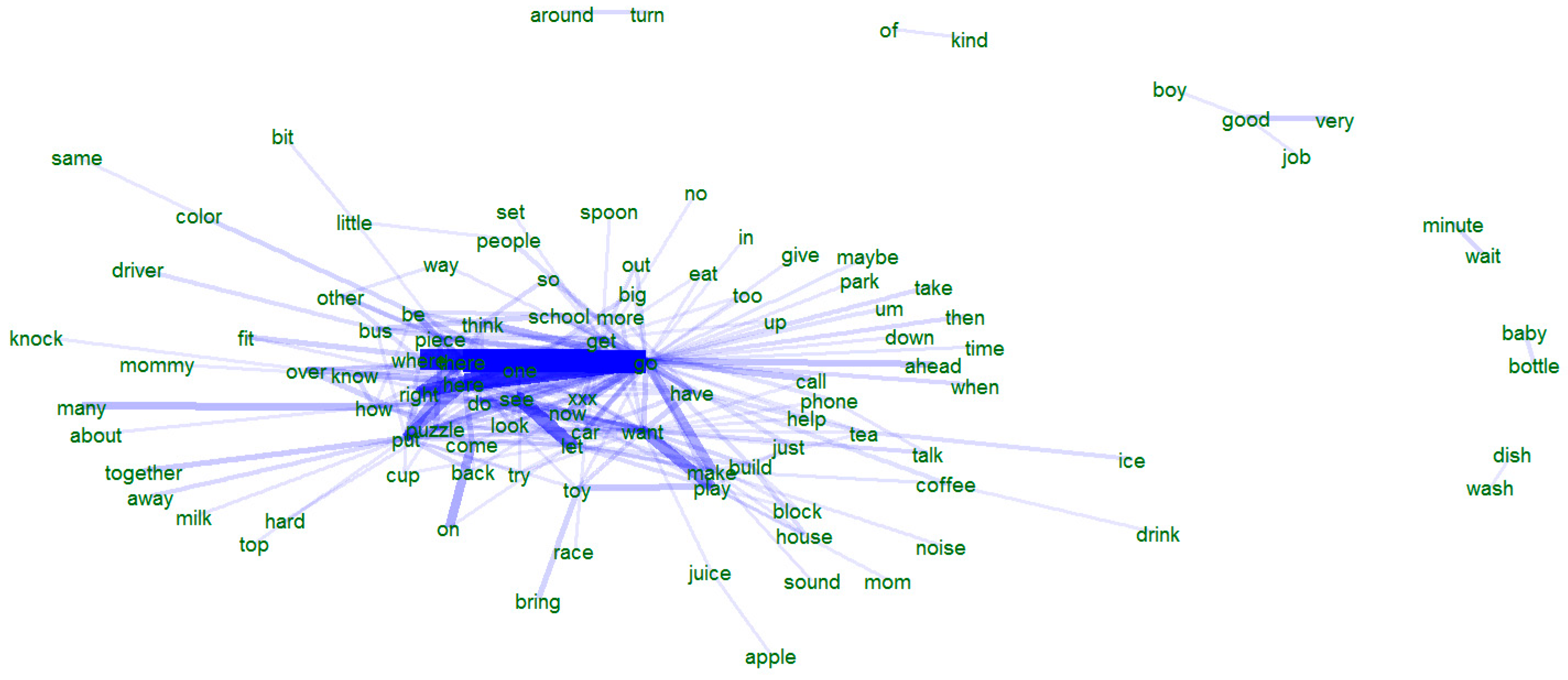
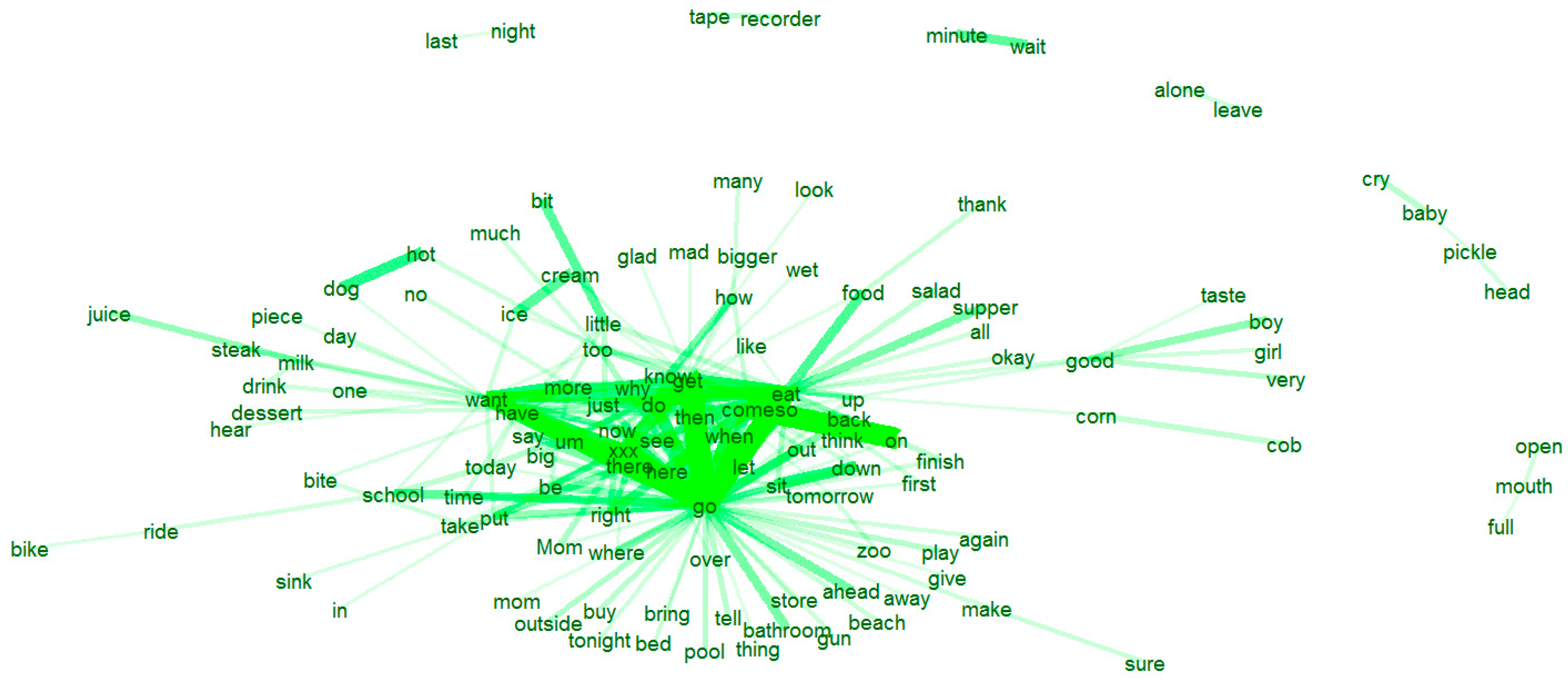
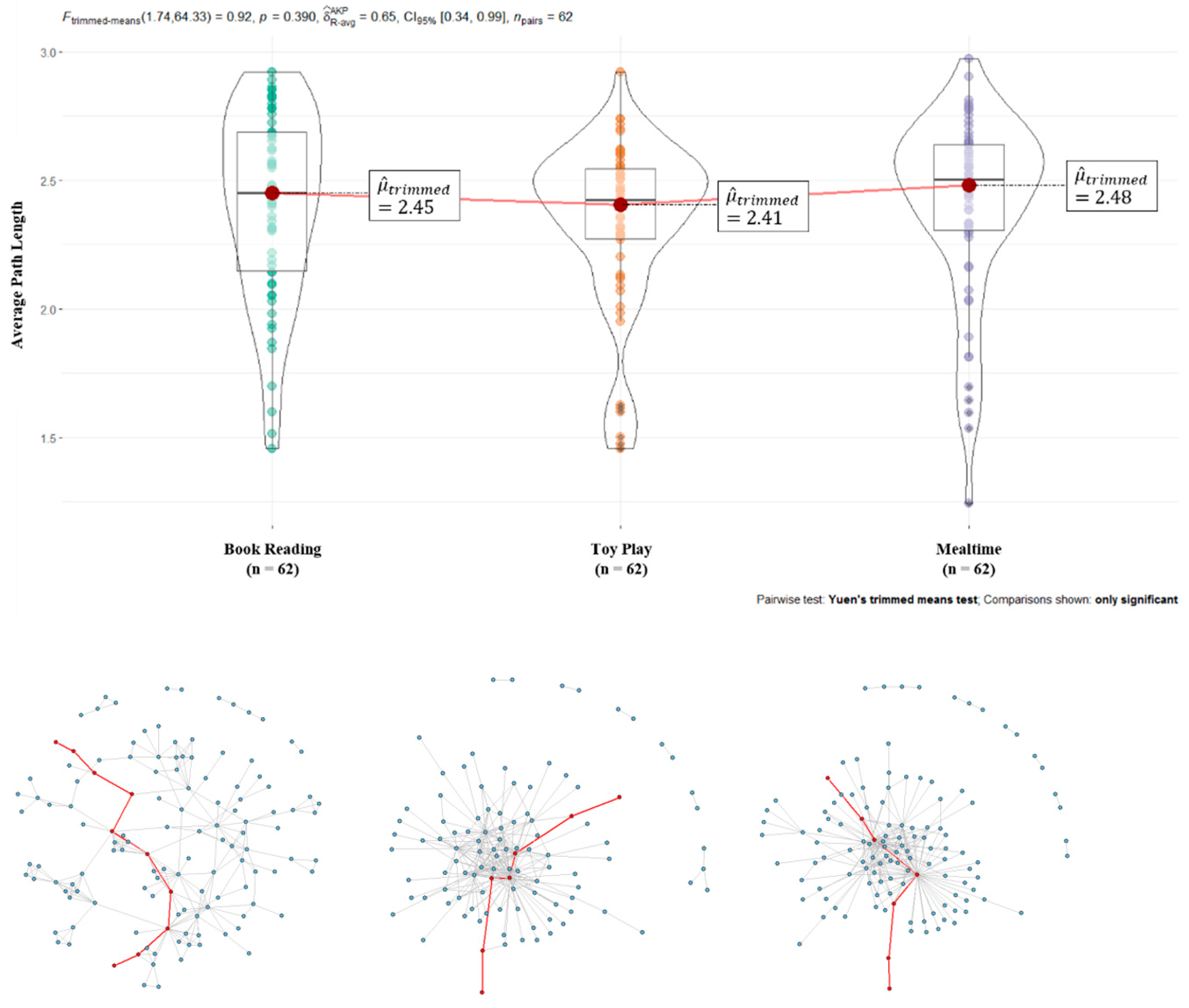
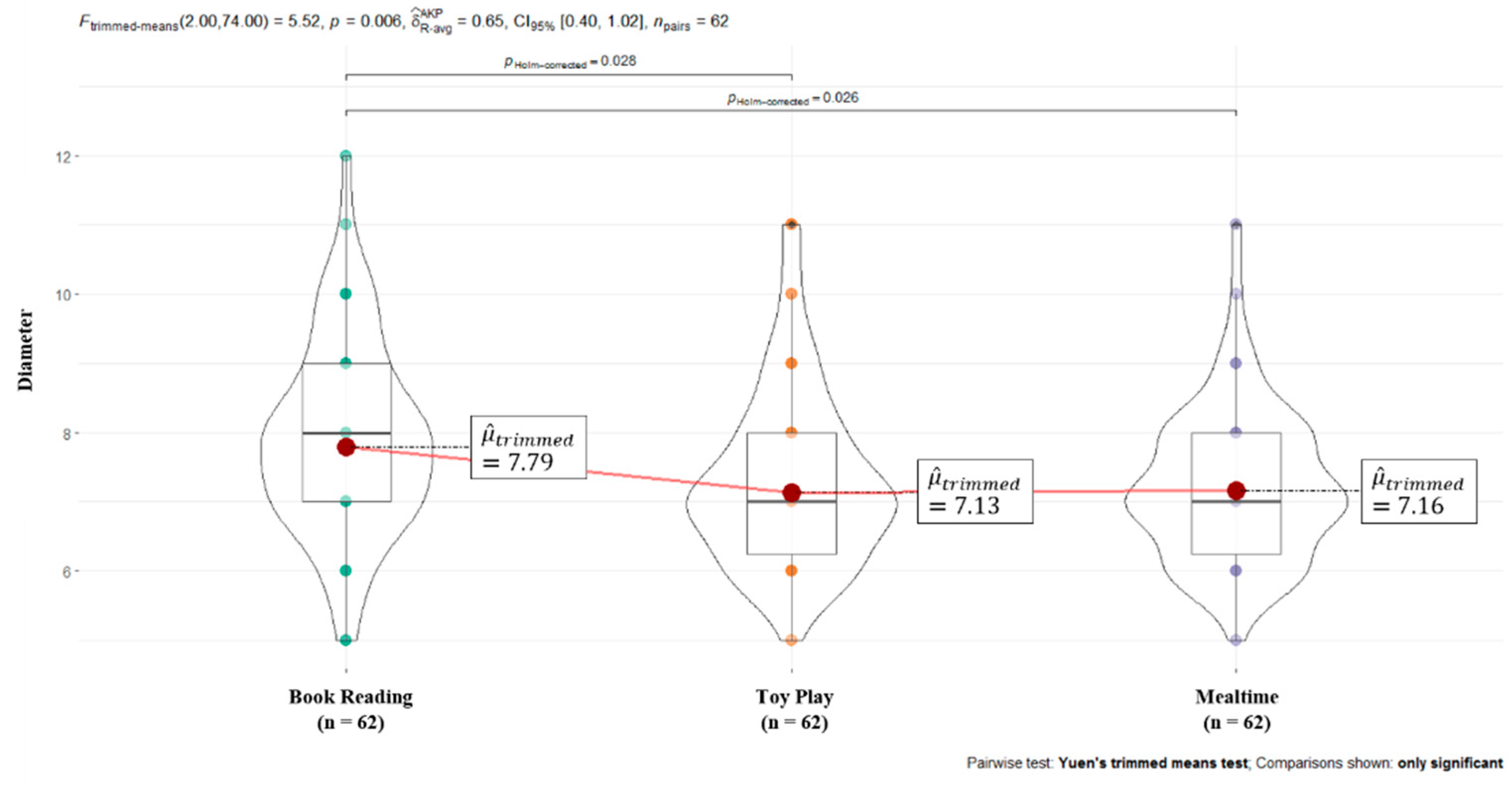

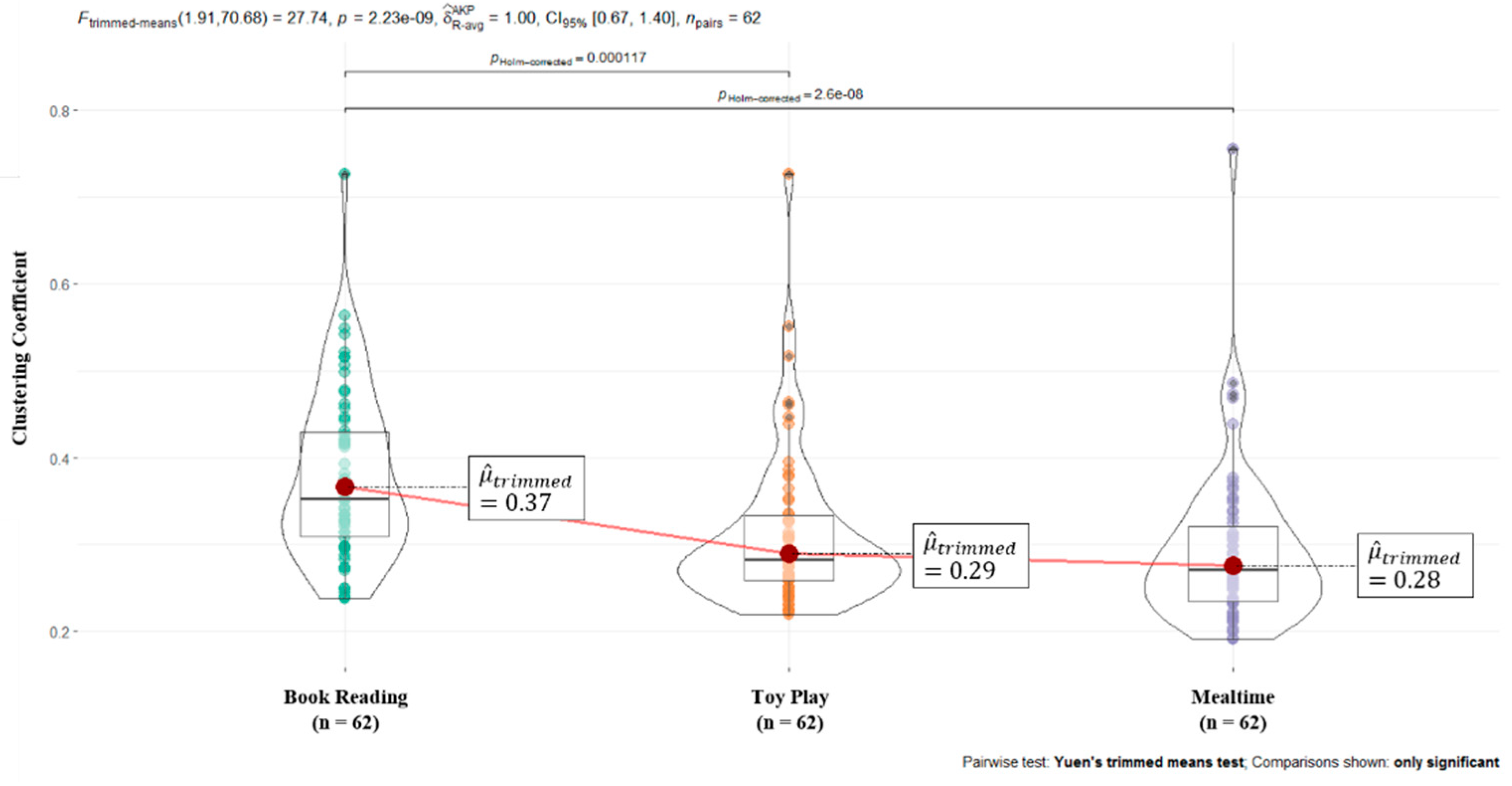
| Type–Token Ratio (TTR) | ||
|---|---|---|
| SE | ||
| Intercept | 0.04 | 0.10 |
| Child Characteristics | ||
| Age | 0.19 + | 0.10 |
| Male | 0.08 | 0.11 |
| Conversation | ||
| Clustering Coefficient | ||
| Book Reading | 0.35 * | 0.16 |
| Toy Play | −0.19 | 0.14 |
| Mealtime | −0.24 | 0.16 |
| The Number of Nodes | ||
| Book Reading | 0.35 | 0.45 |
| Toy Play | 0.60 | 0.39 |
| Mealtime | −0.22 | 0.49 |
| The Number of Edges | ||
| Book Reading | −0.24 | 0.46 |
| Toy Play | −0.50 | 0.35 |
| Mealtime | −0.07 | 0.44 |
Disclaimer/Publisher’s Note: The statements, opinions and data contained in all publications are solely those of the individual author(s) and contributor(s) and not of MDPI and/or the editor(s). MDPI and/or the editor(s) disclaim responsibility for any injury to people or property resulting from any ideas, methods, instructions or products referred to in the content. |
© 2023 by the authors. Licensee MDPI, Basel, Switzerland. This article is an open access article distributed under the terms and conditions of the Creative Commons Attribution (CC BY) license (https://creativecommons.org/licenses/by/4.0/).
Share and Cite
Jang, W.; Leech, K. Contextual Modulation of Adult–Child Language Interaction: Semantic Network Connectivity and Children’s Vocabulary Development. Educ. Sci. 2023, 13, 1084. https://doi.org/10.3390/educsci13111084
Jang W, Leech K. Contextual Modulation of Adult–Child Language Interaction: Semantic Network Connectivity and Children’s Vocabulary Development. Education Sciences. 2023; 13(11):1084. https://doi.org/10.3390/educsci13111084
Chicago/Turabian StyleJang, Wonkyung, and Kathryn Leech. 2023. "Contextual Modulation of Adult–Child Language Interaction: Semantic Network Connectivity and Children’s Vocabulary Development" Education Sciences 13, no. 11: 1084. https://doi.org/10.3390/educsci13111084
APA StyleJang, W., & Leech, K. (2023). Contextual Modulation of Adult–Child Language Interaction: Semantic Network Connectivity and Children’s Vocabulary Development. Education Sciences, 13(11), 1084. https://doi.org/10.3390/educsci13111084





